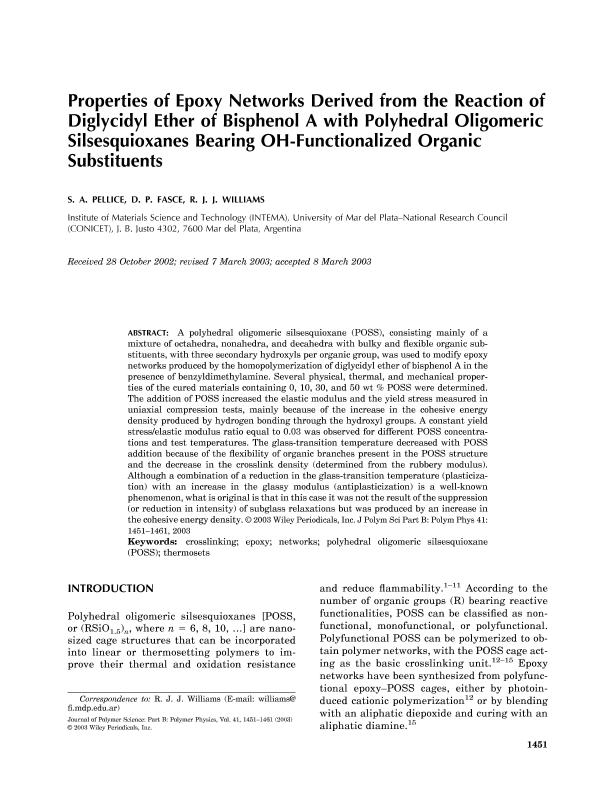Artículo
Properties of epoxy networks derived from the reaction of diglycidyl ether of bisphenol a with polyhedral oligomeric silsesquioxanes bearing OH-functionalized organic substituants
Fecha de publicación:
01/07/2003
Editorial:
John Wiley & Sons Inc
Revista:
Journal of Polymer Science Part B: Polymer Physics
ISSN:
0887-6266
Idioma:
Inglés
Tipo de recurso:
Artículo publicado
Clasificación temática:
Resumen
A polyhedral oligomeric silsesquioxane (POSS), consisting mainly of a mixture of octahedra, nonahedra, and decahedra with bulky and flexible organic sub-stituents, with three secondary hydroxyls per organic group, was used to modify epoxy networks produced by the homopolymerization of diglycidyl ether of bisphenol A in the presence of benzyldimethylamine. Several physical, thermal, and mechanical properties of the cured materials containing 0, 10, 30, and 50 wt % POSS were determined. The addition of POSS increased the elastic modulus and the yield stress measured in uniaxial compression tests, mainly because of the increase in the cohesive energy density produced by hydrogen bonding through the hydroxyl groups. A constant yield stress/elastic modulus ratio equal to 0.03 was observed for different POSS concentrations and test temperatures. The glass-transition temperature decreased with POSS addition because of the flexibility of organic branches present in the POSS structure and the decrease in the crosslink density (determined from the rubbery modulus). Although a combination of a reduction in the glass-transition temperature (plasticization) with an increase in the glassy modulus (antiplasticization) is a well-known phenomenon, what is original is that in this case it was not the result of the suppression (or reduction in intensity) of subglass relaxations but was produced by an increase in the cohesive energy density.
Archivos asociados
Licencia
Identificadores
Colecciones
Articulos(INTEMA)
Articulos de INST.DE INV.EN CIENCIA Y TECNOL.MATERIALES (I)
Articulos de INST.DE INV.EN CIENCIA Y TECNOL.MATERIALES (I)
Citación
Pellice, Sergio Antonio; Fasce, Diana Patricia; Williams, Roberto Juan Jose; Properties of epoxy networks derived from the reaction of diglycidyl ether of bisphenol a with polyhedral oligomeric silsesquioxanes bearing OH-functionalized organic substituants; John Wiley & Sons Inc; Journal of Polymer Science Part B: Polymer Physics; 41; 13; 1-7-2003; 1451-1461
Compartir
Altmétricas




